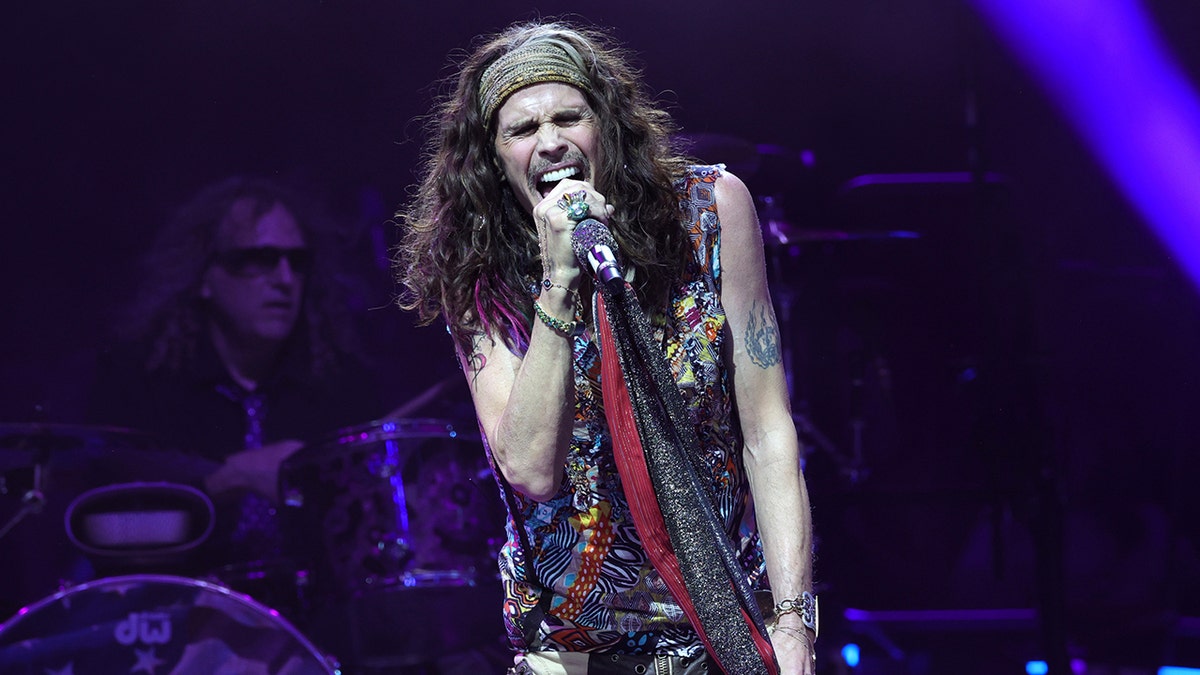Steven Tyler’s latest vocal cord issues has Aerosmith “Living on the Edge” after the band was forced to postpone a string of shows on their “Peace Out” farewell tour due to his throat problems.
It’s not the first time the rock star lost his ability to sing. In 2006, Tyler blew a blood vessel in his throat and was treated by renowned surgeon Dr. Steven Zeitels at Massachusetts General Hospital.
Tyler’s under “strict doctor’s orders not to sing for the next thirty days” after sustaining vocal damage which caused “bleeding.” It’s unclear if the musician will require any surgeries or further medical attention.
Zeitels has treated a number of stars who have undergone vocal nodule surgeries, including Adele, Julie Andrews, Keith Urban and Paul Stanley.
STEVEN TYLER INJURES VOCAL CORDS, AEROSMITH POSTPONES FAREWELL TOUR SHOWS
Steven Tyler, Adele and Julie Andres have each faced vocal cord issues throughout their careers. (Getty Images)
On Monday, Tyler shared on the band’s social media platforms, “I’m heartbroken to say I have received strict doctor’s orders not to sing for the next thirty days.”
“I sustained vocal cord damage during Saturday’s show that led to subsequent bleeding. We’ll need to postpone a few dates so that we can come back and give you the performance you deserve.”
Fox News Digital contacted Tyler’s representatives for updated information about his health.
The surgeon, who has a long roster of celebrity clients, noted that “metal singers” tend to cause the most trauma to their voices more commonly than in any other genres of music.
“You’re screaming, that’s trauma. But most things singers get is just trauma,” Zeitels told Macleans. “They go out and sing when they’re sick, they don’t want to let people down, the pressures of touring.
“Bleeding is very common, that was something Steven Tyler had, Adele had, Sam [Smith] had, Lionel had. I developed a newer approach about seven years ago with a specialized laser, which is also for cancer, which can stop the vocal bleeding and not burn the vocal cord at all—to the point that it can actually function better. Previously, it would cauterize them, and it would stiffen the cord. I think that changed the game: you have a precise way so singers didn’t have to be fearful that their voice would be ruined by treating the bleeding.”

Tyler said he was on 30 days of vocal rest following a concert stop in New York. (Lisa Lake)

Steven Tyler is on vocal rest for 30 days after injuring his vocal cords on farewell tour. (Kevin Mazur)
Tyler was one of the first patients to receive the voice surgery (phonosurgery) in August 2006.
Shortly after Adele released her second album, “21,” and just as she was becoming a household name in the United States, the “Someone Like You” singer was forced to cancel two tours due to a vocal cord hemorrhage.
The British singer underwent the same vocal cord surgery in 2011 with Zeitels to stop hemorrhaging caused by a benign polyp on her vocal cord.
ADELE, OPRAH, ETHAN SUPLEE: HOLLYWOOD’S BIGGEST WEIGHT LOSS JOURNEYS
She was on strict orders to remain on vocal rest for weeks after the surgery, and returned to singing at the Grammys in February 2012 where she nabbed six awards.
During her acceptance speech for best pop vocal performance, Adele credited her medical team for saving her voice.
“Seeing as it’s a vocal performance, I need to thank my doctors, I suppose, who brought my voice back,” Adele said.
Zeitels said many stars are fearful over surgery due to the nature of the procedure. Julie Andrews underwent vocal surgery to remove nodules in 1997, and was not only left with permanent damage to her four-octave range, but also changes to her vocal quality.
“That was one of the most formidable voices of the late-20th century and after surgery she could no longer sing again,” Zeitels told the publication. “That creates fear.”

When Adele returned to the stage after weeks of vocal rest, she thanked her doctors for saving her voice. (Gareth Cattermole)

Adele required surgery in 2011 due to a polyp on her vocal cord. (Gareth Cattermole)

Julie Andrews feared losing her voice forever after a botched surgery in 1997. (Axelle/Bauer-Griffin)
Shortly after the operation, Andrews filed a malpractice suit against her doctors and New York City’s Mount Sinai Hospital. She told AARP The Magazine in 2019 that she “went into a depression” and felt like she lost her identity following the surgery.
The “Sound of Music” star settled the lawsuit in 2000 for an undisclosed amount.
Through phonomicrosurgery, Zeitels helped Andrews recover at least some of her voice.
LIKE WHAT YOU’RE READING? CLICK HERE FOR MORE ENTERTAINMENT NEWS
“What I can say to you is that—that happened in the late 1990s, and I was able, with procedures, to enhance her voice but not to the point like it was the type of singing she could do before—but the fascinating thing was that when I was developing the procedures, people were learning about it from the late 90s to 2010s, what seemed to change things substantially was the case with Adele,” Zeitels said.
“So many people knew about it, and she did quite well at the Grammys, and I thought that was very fortunate.”
Andrews became such a supporter of Zeitels’ that she serves as the Honorary Chairwoman of his Voice Health Institute.
“In that time period was also when I helped Lionel Richie and Keith Urban and Paul Stanley of KISS, a whole range of people all of whom were realizing that the procedures were better,” he said.

Keith Urban required vocal surgery in 2011. (Maggie Friedman)

Justin Timberlake had vocal surgery in 2005. (Matt Winkelmeyer)
Keith Urban had successful throat surgery in 2011 to remove a polyp from his vocal cord.
The noncancerous growths are similar to calluses on vocal folds, and can cause voices to become hoarse and raspy. Polyps are usually caused by overuse of the voice.
Urban’s three-week silent period seemed to do the trick as he’s still performing today with little to no issues.
CLICK HERE TO SIGN UP FOR THE ENTERTAINMENT NEWSLETTER
Zeitels also treated Lionel Richie, who endured a total of four procedures in the ’90s. He told People magazine that he was “about as close as you ever would’ve come to a nervous breakdown” while trying to figure out his vocal issues.
“You don’t want anybody fooling around down there. This is your identity,” he said, adding, “I never really thought that it would end.”

Lionel Richie recalled almost having a nervous breakdown while enduring multiple rounds of throat surgeries in the ’90s. (Chris Jackson)
Justin Timberlake had surgery to remove nodules from his vocal cords in May 2005. Almost 13 years later, the “Can’t Stop the Feeling” singer postponed a string of shows due to bruised vocal cords.
Sam Smith was forced to cancel a handful of shows due to damaged vocal cords.
The “Stay With Me” singer had a successful surgery in May 2015.
CLICK HERE TO GET THE FOX NEWS APP
“I think today, what ends up happening is that the real high-level fear, with what’s associated with Julie Andrews’ surgery, is diminished substantially,” Zeitels said.
“They’re realizing they’re athletes, and they might need restorative surgery, and tend to look today like it’s an opportunity to do better—not that you run to do it.”